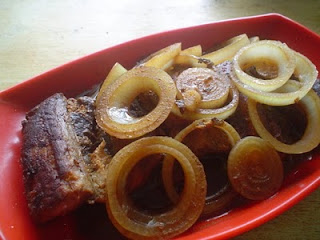Lenten (Re)treat
Before Ash Wednesday, I was able to listen to a talk of a seminarian who gave quite a comprehensive explanation of why we go through the Lenten season. I keep forgetting his name (in the off-chance that your reading this, brother seminarian, I'm so, so sorry!), but I cannot forget his very thorough explanation.
First, he explained the origin of the definition of the word Lent: first word - quadragesima, a Latin word which simply means 40 (to Christians, the number 40 is a very significant number as it denotes completion of a mission or task in preparation for a greater mission; second word - fastenzeit, a German word that has the word fast in it, so I guess this is self-explanatory; and Lencten - an old English word that signifies a springtime.
(Note: Honestly, I cannot explain Lent like how Br. Michael Angelo did. I just remembered these three foreign words and that was it. So, to understand what Lent truly means and how to celebrate it, please click this link. But you have to congratulate me for recalling what brother seminarian's name is. Also, please be patient with the video as it contains the whole session, including the Mass.)


Anyway, two days from today, it will be the fourth Sunday of Lent already. And as we come towards the end of the Lenten season, I'm sure those who are observing Lent by abstaining from meat is already having a hard time thinking of dishes to prepare. As Tito Niki said, when cooking fish, the only methods he could think of are paksiw, fried and sinigang.
Of course, these cooking methods are pretty standard. But this Lenten season, let's not limit ourselves to these modes of preparing fish and seafood. And so, allow me to share some recipes that could make abstinence from meat more interesting.
Bangus Steak (In honor of Tita Tel, my sis-in-law Sheila's mom)
You will need:
- a packet of bangus back fillet or bangus belly
- 1/4 cup soy sauce
- juice from 8 pieces calamansi
- a pinch or two of finely ground black pepper
- 1/2 cup water
- cooking oil for frying
- one big white onion, cut into rings
First, marinate the bangus in soy sauce and calamansi juice for at least half a day (overnight is good, too).
Heat up your frying pan, pour the oil and adjust heat to medium. Fry the marinated bangus. Set aside.
Remove the cooking oil from the frying pan. Pour the marinade plus water and allow to boil over medium heat. Next, add the fried fish and onion rings and cover. Reduce heat to low. Continue simmering until liquid is reduced and onion rings are separated.
Transfer into a serving dish. Arrange onion rings on top of the bangus steak and serve with steamed rice.
Fish Afritada
(Note: Sorry, I forgot to take a picture of this dish. I'll make it again and post it here later on.)
Ingredients:
- 1 kilo of any freshwater fish (tilapia, cut into half; boneless bangus back fillet or belly; dalag or mudfish, cut into steaks)
- cooking oil for frying
- 5 pieces laurel leaves (you can add more if you have more than a kilo of fish)
- Maggi Magic Sarap, to taste
- 3 tablespoons tomato paste
- 1 cup water
- 2 carrots, peeled and sliced 1/2" thick
- 2 small potatoes, peeled and quartered
- 2 small kamote, peeles and quartered
- a handful of Baguio beans, trimmed and cut in half
- 1 each of green and red bell pepper, cut into 8
- a pinch or 2 of ground black pepper
Heat frying pan and fry the fish with crushed laurel leaves and a sprinkling of Maggi Magic Sarap seasoning.
When the fish is brown, remove some of the cooking oil and add the tomato paste. Add water and simmer for 2 minutes. Add the carrots, potatoes and kamote and simmer for another 5 minutes or until th potatoes are tender. Adjust taste according to your liking.
Add the beans, cover and simmer for a minute. Put a pinch or 2 of black pepper then add the bell peppers. Cover and turn off fire.

Now, if you are having fried fish (again!), make sure you prepare a side dish that will complement it. One thing for sure, you can't go wrong with boiled or steamed veggies. What I do with my veggies is that when I cook rice in my rice cooker, I put the vegetables (eggplants, okra, kamote tops, ampalaya, sigarilyas) into the steamer rack and place it on top of the cooker. That way, the vegetables get cooked together with the rice.
What's nice about steaming veggies as opposed to boiling them in water is that the veggies do not lose any vitamins in the boiling water.
Just arrange the veggies on a nice plate and place a variety of condiments around them. I like mine with bagoong isda/ balayan with calamansi. You can also use soy sauce with calamansi or bagoong alamang guisado.
Or, if you're feeling a little crazy, make some Crazy Salad!

It's basically steamed veggies too, with some sliced onions and tomatoes tossed in and bagoong isda with calamansi juice as dipping sauce. I had this while we were in Ilocos, at the Chicken Ati-atihan.
Of course, the choices of craziness can be limitless. You can chop some green mangoes and toss them in for a crazier fare.
There you have it, folks! I'll post some more later, I promise. Enjoy!



Comments
thanks ha? yes, mas magiging masipag na ako mag-post.